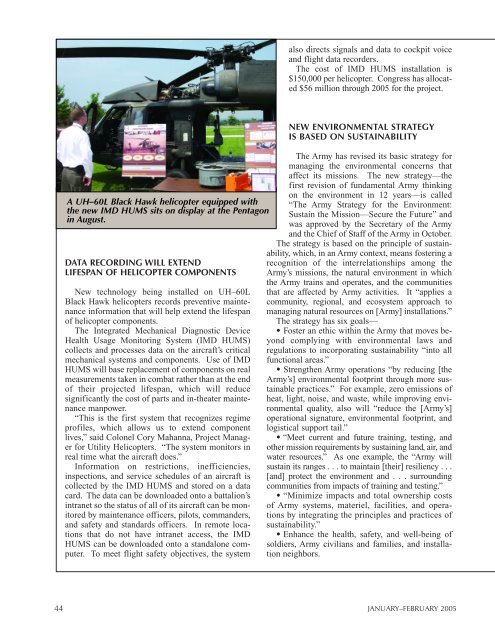Supporting the First Stryker Brigade in Iraq - Army Logistics ...
Supporting the First Stryker Brigade in Iraq - Army Logistics ...
Supporting the First Stryker Brigade in Iraq - Army Logistics ...
You also want an ePaper? Increase the reach of your titles
YUMPU automatically turns print PDFs into web optimized ePapers that Google loves.
44<br />
A UH–60L Black Hawk helicopter equipped with<br />
<strong>the</strong> new IMD HUMS sits on display at <strong>the</strong> Pentagon<br />
<strong>in</strong> August.<br />
DATA RECORDING WILL EXTEND<br />
LIFESPAN OF HELICOPTER COMPONENTS<br />
New technology be<strong>in</strong>g <strong>in</strong>stalled on UH–60L<br />
Black Hawk helicopters records preventive ma<strong>in</strong>tenance<br />
<strong>in</strong>formation that will help extend <strong>the</strong> lifespan<br />
of helicopter components.<br />
The Integrated Mechanical Diagnostic Device<br />
Health Usage Monitor<strong>in</strong>g System (IMD HUMS)<br />
collects and processes data on <strong>the</strong> aircraft’s critical<br />
mechanical systems and components. Use of IMD<br />
HUMS will base replacement of components on real<br />
measurements taken <strong>in</strong> combat ra<strong>the</strong>r than at <strong>the</strong> end<br />
of <strong>the</strong>ir projected lifespan, which will reduce<br />
significantly <strong>the</strong> cost of parts and <strong>in</strong>-<strong>the</strong>ater ma<strong>in</strong>tenance<br />
manpower.<br />
“This is <strong>the</strong> first system that recognizes regime<br />
profiles, which allows us to extend component<br />
lives,” said Colonel Cory Mahanna, Project Manager<br />
for Utility Helicopters. “The system monitors <strong>in</strong><br />
real time what <strong>the</strong> aircraft does.”<br />
Information on restrictions, <strong>in</strong>efficiencies,<br />
<strong>in</strong>spections, and service schedules of an aircraft is<br />
collected by <strong>the</strong> IMD HUMS and stored on a data<br />
card. The data can be downloaded onto a battalion’s<br />
<strong>in</strong>tranet so <strong>the</strong> status of all of its aircraft can be monitored<br />
by ma<strong>in</strong>tenance officers, pilots, commanders,<br />
and safety and standards officers. In remote locations<br />
that do not have <strong>in</strong>tranet access, <strong>the</strong> IMD<br />
HUMS can be downloaded onto a standalone computer.<br />
To meet flight safety objectives, <strong>the</strong> system<br />
also directs signals and data to cockpit voice<br />
and flight data recorders.<br />
The cost of IMD HUMS <strong>in</strong>stallation is<br />
$150,000 per helicopter. Congress has allocated<br />
$56 million through 2005 for <strong>the</strong> project.<br />
NEW ENVIRONMENTAL STRATEGY<br />
IS BASED ON SUSTAINABILITY<br />
The <strong>Army</strong> has revised its basic strategy for<br />
manag<strong>in</strong>g <strong>the</strong> environmental concerns that<br />
affect its missions. The new strategy—<strong>the</strong><br />
first revision of fundamental <strong>Army</strong> th<strong>in</strong>k<strong>in</strong>g<br />
on <strong>the</strong> environment <strong>in</strong> 12 years—is called<br />
“The <strong>Army</strong> Strategy for <strong>the</strong> Environment:<br />
Susta<strong>in</strong> <strong>the</strong> Mission—Secure <strong>the</strong> Future” and<br />
was approved by <strong>the</strong> Secretary of <strong>the</strong> <strong>Army</strong><br />
and <strong>the</strong> Chief of Staff of <strong>the</strong> <strong>Army</strong> <strong>in</strong> October.<br />
The strategy is based on <strong>the</strong> pr<strong>in</strong>ciple of susta<strong>in</strong>ability,<br />
which, <strong>in</strong> an <strong>Army</strong> context, means foster<strong>in</strong>g a<br />
recognition of <strong>the</strong> <strong>in</strong>terrelationships among <strong>the</strong><br />
<strong>Army</strong>’s missions, <strong>the</strong> natural environment <strong>in</strong> which<br />
<strong>the</strong> <strong>Army</strong> tra<strong>in</strong>s and operates, and <strong>the</strong> communities<br />
that are affected by <strong>Army</strong> activities. It “applies a<br />
community, regional, and ecosystem approach to<br />
manag<strong>in</strong>g natural resources on [<strong>Army</strong>] <strong>in</strong>stallations.”<br />
The strategy has six goals—<br />
• Foster an ethic with<strong>in</strong> <strong>the</strong> <strong>Army</strong> that moves beyond<br />
comply<strong>in</strong>g with environmental laws and<br />
regulations to <strong>in</strong>corporat<strong>in</strong>g susta<strong>in</strong>ability “<strong>in</strong>to all<br />
functional areas.”<br />
• Streng<strong>the</strong>n <strong>Army</strong> operations “by reduc<strong>in</strong>g [<strong>the</strong><br />
<strong>Army</strong>’s] environmental footpr<strong>in</strong>t through more susta<strong>in</strong>able<br />
practices.” For example, zero emissions of<br />
heat, light, noise, and waste, while improv<strong>in</strong>g environmental<br />
quality, also will “reduce <strong>the</strong> [<strong>Army</strong>’s]<br />
operational signature, environmental footpr<strong>in</strong>t, and<br />
logistical support tail.”<br />
• “Meet current and future tra<strong>in</strong><strong>in</strong>g, test<strong>in</strong>g, and<br />
o<strong>the</strong>r mission requirements by susta<strong>in</strong><strong>in</strong>g land, air, and<br />
water resources.” As one example, <strong>the</strong> “<strong>Army</strong> will<br />
susta<strong>in</strong> its ranges . . . to ma<strong>in</strong>ta<strong>in</strong> [<strong>the</strong>ir] resiliency . . .<br />
[and] protect <strong>the</strong> environment and . . . surround<strong>in</strong>g<br />
communities from impacts of tra<strong>in</strong><strong>in</strong>g and test<strong>in</strong>g.”<br />
• “M<strong>in</strong>imize impacts and total ownership costs<br />
of <strong>Army</strong> systems, materiel, facilities, and operations<br />
by <strong>in</strong>tegrat<strong>in</strong>g <strong>the</strong> pr<strong>in</strong>ciples and practices of<br />
susta<strong>in</strong>ability.”<br />
• Enhance <strong>the</strong> health, safety, and well-be<strong>in</strong>g of<br />
soldiers, <strong>Army</strong> civilians and families, and <strong>in</strong>stallation<br />
neighbors.<br />
JANUARY–FEBRUARY 2005







